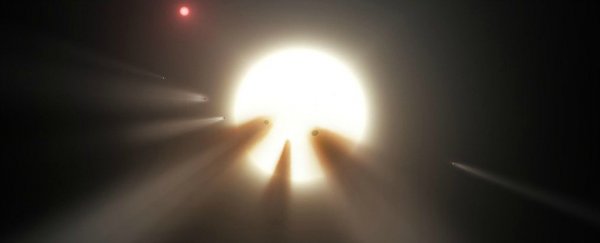By now, you're probably all familiar with Tabby's star - better known as "that weird alien megastructure star" - which was first detected last year and has baffled scientists with its irregular dimming patterns.
Most stars periodically get around 1 percent dimmer as exoplanets pass in front of them, but the way the light from Tabby's dips was so erratic and extreme that it led one scientist to speculate that maybe a giant alien structure, such as a Dyson sphere, was in orbit around the star.
Skeptical about that suggestion (understandably), astronomers have since been actively investigating the 1,480-light-years-away star - officially called KIC 8462852 - and its surroundings to figure out what's going on.
Everything we've found out since then just keeps getting weirder - we now know that not only does the star randomly dip in brightness by up to 20 percent, but it's also been progressively dimming over the past century.
The truth is no one really knows what's going on as yet, but one of the leading hypotheses - which has already had holes poked in it - is that a weird comet cluster or mass of planetary debris is orbiting Tabby's star.
But now a new paper has come out, proposing an alternate hypothesis: a duo of researchers has found early evidence that maybe the strange dimming pattern isn't coming from around Tabby's star at all - maybe it's interstellar clutter in the space between stars that's causing the weirdness.
Here's what they found - after looking at the smallest dips in light of Tabby's star, Valeri Makarov, from the US Naval Observatory in Washington DC, and Alexey Goldin, from Teza Technologies in Chicago, noticed that Tabby's star isn't necessarily responsible for the dimming.
In fact, they noticed that when these smalls dips in light occurred - ranging between a 0.1 and 7 percent reduction in brightness - the position of the light also moves slightly, which suggests that there's actually a different star along our line of sight that's dimming.
But that doesn't mean Tabby's star is in the clear - the largest dips of 20 percent were definitely still coming from KIC 8462852, the researchers concluded.
So what can we make of all that? The team suggests that if not just one, but two stars, are dimming along the same sight line, then it's probably not because of something orbiting Tabby's star, but more likely is the result of some kind of clutter in interstellar space.
It's not yet clear what that could be, but in a pre-print paper published on Arxiv, the team speculate that it could be a cluster of comets or planetoids lying between the two stars. Comets are leftover material from planetary formation that are usually found in solar systems, but they can often be ejected from a star's orbit by planetary scattering.
No interstellar comets have ever been detected, but seeing as comets are so dark, it makes sense that it would be incredibly difficult to spot them in the darkness between stars.
"Maybe interstellar space is full of free-floating comets," Makarov told Shannon Hall from New Scientist. "But try to find them! They are dark and cold, and travelling from nowhere to nowhere, basically, forever."
Once again, this is just a hypothesis, and one that hasn't been published in a peer-review journal just yet - the authors have put it up on Arxiv in the hopes of attracting more feedback from other researchers before they submit it for publication. More observations and research are definitely needed to test out whether or not there's any evidence to support the idea.
But already Jason Wright, the astronomer from Pennsylvania State University who first came up with the alien megastructure idea, has already told New Scientist that the idea would make a lot of sense if there really is a second dimming star.
"If this is right, then that conclusion is dead on," he said.
He also explained that an interstellar cloud of some kind could explain the gradual but unexpected dimming of Tabby's star over the past century - as the bulk of the cloud moves across our line of sight, it could slowly block more and more light coming from the star.
It could also provide some insight into why astronomers found a second, even weirder, megastructure star just a few weeks ago.
The big problem is that not only do we not know about any interstellar comets or clouds in that region of space, but it would be incredibly difficult to spot them even if we wanted to.
Makarov suggests that the best option might be to wait a few decades until the second star has moved out of our line of sight from Tabby's star, and we can get a clearer view of what's going on.
Either way, grab some popcorn, because we're in this for the long haul. One thing's for sure - you haven't heard the last about Tabby's star yet.
